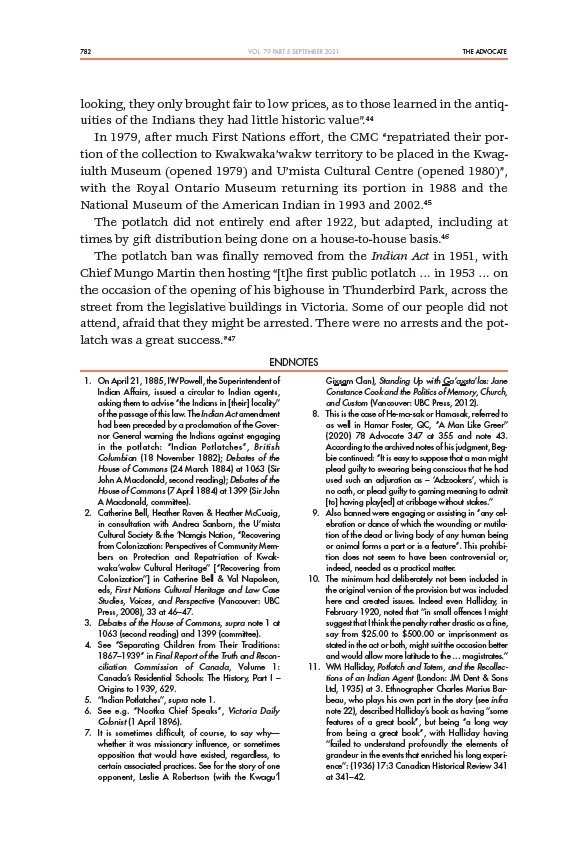
782 THE ADVOCATE
VOL. 79 PART 5 SEPTEMBER 2021
looking, they only brought fair to low prices, as to those learned in the antiquities
of the Indians they had little historic value”.44
In 1979, after much First Nations effort, the CMC “repatriated their portion
of the collection to Kwakwaka’wakw territory to be placed in the Kwagiulth
Museum (opened 1979) and U’mista Cultural Centre (opened 1980)”,
with the Royal Ontario Museum returning its portion in 1988 and the
National Museum of the American Indian in 1993 and 2002.45
The potlatch did not entirely end after 1922, but adapted, including at
times by gift distribution being done on a house-to-house basis.46
The potlatch ban was finally removed from the Indian Act in 1951, with
Chief Mungo Martin then hosting “the first public potlatch … in 1953 … on
the occasion of the opening of his bighouse in Thunderbird Park, across the
street from the legislative buildings in Victoria. Some of our people did not
attend, afraid that they might be arrested. There were no arrests and the potlatch
was a great success.”47
ENDNOTES
1. On April 21, 1885, IW Powell, the Superintendent of
Indian Affairs, issued a circular to Indian agents,
asking them to advise “the Indians in their locality”
of the passage of this law. The Indian Act amendment
had been preceded by a proclamation of the Governor
General warning the Indians against engaging
in the potlatch: “Indian Potlatches”, British
Columbian (18 November 1882); Debates of the
House of Commons (24 March 1884) at 1063 (Sir
John A Macdonald, second reading); Debates of the
House of Commons (7 April 1884) at 1399 (Sir John
A Macdonald, committee).
2. Catherine Bell, Heather Raven & Heather McCuaig,
in consultation with Andrea Sanborn, the U’mista
Cultural Society & the ‘Namgis Nation, “Recovering
from Colonization: Perspectives of Community Members
on Protection and Repatriation of Kwakwaka’wakw
Cultural Heritage” “Recovering from
Colonization” in Catherine Bell & Val Napoleon,
eds, First Nations Cultural Heritage and Law Case
Studies, Voices, and Perspective (Vancouver: UBC
Press, 2008), 33 at 46–47.
3. Debates of the House of Commons, supra note 1 at
1063 (second reading) and 1399 (committee).
4. See “Separating Children from Their Traditions:
1867–1939” in Final Report of the Truth and Reconciliation
Commission of Canada, Volume 1:
Canada’s Residential Schools: The History, Part I –
Origins to 1939, 629.
5. “Indian Potlatches”, supra note 1.
6. See e.g. “Nootka Chief Speaks”, Victoria Daily
Colonist (1 April 1896).
7. It is sometimes difficult, of course, to say why—
whether it was missionary influence, or sometimes
opposition that would have existed, regardless, to
certain associated practices. See for the story of one
opponent, Leslie A Robertson (with the Kwagu’l
Gixsam Clan), Standing Up with Ga’axsta’las: Jane
Constance Cook and the Politics of Memory, Church,
and Custom (Vancouver: UBC Press, 2012).
8. This is the case of He-ma-sak or Hamasak, referred to
as well in Hamar Foster, QC, “A Man Like Greer”
(2020) 78 Advocate 347 at 355 and note 43.
According to the archived notes of his judgment, Begbie
continued: “It is easy to suppose that a man might
plead guilty to swearing being conscious that he had
used such an adjuration as – ‘Adzookers’, which is
no oath, or plead guilty to gaming meaning to admit
to having played at cribbage without stakes.”
9. Also banned were engaging or assisting in “any celebration
or dance of which the wounding or mutilation
of the dead or living body of any human being
or animal forms a part or is a feature”. This prohibition
does not seem to have been controversial or,
indeed, needed as a practical matter.
10. The minimum had deliberately not been included in
the original version of the provision but was included
here and created issues. Indeed even Halliday, in
February 1920, noted that “in small offences I might
suggest that I think the penalty rather drastic as a fine,
say from $25.00 to $500.00 or imprisonment as
stated in the act or both, might suit the occasion better
and would allow more latitude to the … magistrates.”
11. WM Halliday, Potlatch and Totem, and the Recollections
of an Indian Agent (London: JM Dent & Sons
Ltd, 1935) at 3. Ethnographer Charles Marius Barbeau,
who plays his own part in the story (see infra
note 22), described Halliday’s book as having “some
features of a great book”, but being “a long way
from being a great book”, with Halliday having
“failed to understand profoundly the elements of
grandeur in the events that enriched his long experience”:
(1936) 17:3 Canadian Historical Review 341
at 341–42.